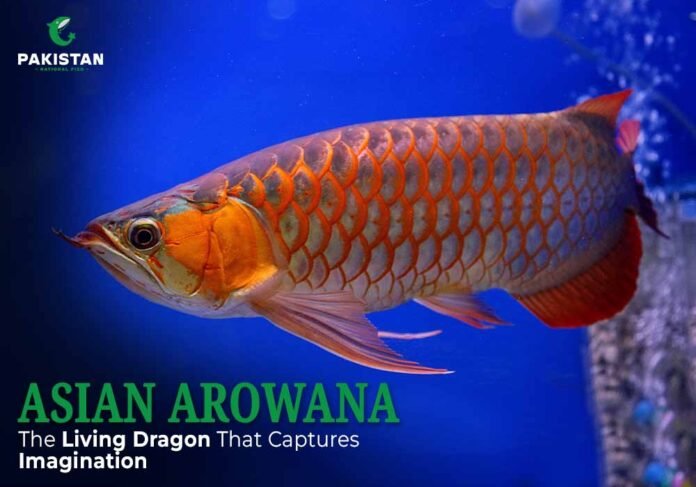Where Myth Meets Water
Long before the Asian Arowana appeared in home aquariums, it ruled the murky black water rivers of Southeast Asia. Locals along the Kapuas and Batang Hari Rivers used to tell stories of a golden dragon that guarded the forest streams. When they finally described it to scientists, it turned out to be this fish—sleek, ancient, and shining like molten metal under sunlight.
That’s how the legend began.
The Arowana’s long, scaled body and whisker-like barbels resemble the dragons carved into temple doors and royal emblems. In Chinese folklore, the dragon is a sacred symbol of strength, prosperity, and protection. It isn’t hard to see how this fish, gliding with quiet command, came to embody the same energy.
Even today, many aquarists swear that having an Arowana brings balance to their home. Feng Shui masters place it where energy flows freely—believing it stirs good fortune, guard’s wealth, and draws positive chi. Whether or not you believe in luck, it’s difficult to deny the calm confidence this fish radiates.
Nature’s Ancient Design
Few aquarium species are as captivating as the Asian Arowana, scientifically known as Scleropages formosus. Its lineage traces back over 100 million years—making it one of the oldest freshwater fish still alive today.
In the wild, it thrives in slow-moving rivers shaded by thick jungle canopy. The water is soft, slightly acidic, and often tinted tea-brown by leaves and roots. This natural environment shaped its design: a surface hunter with keen eyesight, built to leap from the water to snatch prey mid-air.
When kept in captivity, that instinct never fades. Aquarists often describe hearing a sudden splash—a reminder that even in a glass tank, the dragon’s wild heart still beats.
Varieties That Tell Their Own Story
Every Arowana variety seems to carry its own personality and prestige.
- Green Arowana: Common across Thailand and Borneo; a modest yet elegant species with earthy green scales.
- Silver Arowana: Sleek and fast, native to the Amazon—more affordable, but just as charismatic.
- Golden Arowana: Belonging to a locality of Malaysia; its dermal denticles glisten like 24-karat gold, generally seen as a sign of prosperity.
- Red Arowana: The icon of Indonesia’s rivers, its blood red color gives it a savage, nearly fascinating look.
- Jardini Arowana: From Australia, smaller but bold, often kept by aquarists who appreciate a challenge.
Of them all, the 24K Crossback Golden Arowana sits at the top of every collector’s list. Its glow is so intense that under proper lighting, it looks sculpted from gold leaf. In luxury markets, these fish can sell for tens of thousands of dollars—each one micro-chipped and certified due to strict conservation laws.
The Art of Keeping a Dragon
Raising an Asian Arowana is not for the faint-hearted. It’s a demanding fish—intelligent, moody, and territorial. Yet those who succeed describe the experience as transformative.
Tank Essentials
A juvenile might start comfortably in a 150-gallon tank, but an adult requires no less than 250–300 gallons—longer tanks are better than tall ones. The water should stay warm, between 75°F and 86°F, with a pH of 6.0 to 7.5. Arowanas dislike fluctuation; stability is key.
They’re also exceptional jumpers. In the wild, they can leap six feet to catch insects. At home, that means you need a tight, heavy lid—many heartbreaking escapes have ended with prized fish found on the floor.
Creating Calm
These fish don’t need decorations as much as they need space. Smooth driftwood and dim lighting make them feel secure. Avoid loud noises or sudden movements near the tank; the Arowana is easily startled and might injure itself against the glass.
Feeding the Dragon
Feeding an Arowana is part science, part ritual. Watching it rise to the surface with slow precision feels almost ceremonial.
Their natural diet includes insects, shrimp, and small fish. In aquariums, variety is vital for color and vitality. A well-fed Arowana’s scales gleam brighter, and its movement becomes more fluid.
A well-rounded diet may include:
- Frozen or live shrimps
- Mealworms, crickets, or earthworms
- Fish fillets or quality carnivorous pellets
- Occasional treats like krill or prawns
Juveniles eat two to three times a day; adults once daily is enough. Never overfeed—it dulls their color and pollutes the water. Feed them like you’d feed royalty: little, but perfect.
Temperament and Companionship
Arowanas are natural-born rulers. They do not share their territory easily, and forcing companionship can turn a peaceful aquarium into a battlefield.
If you have the space, certain tank mates can coexist—large, bottom-dwelling species such as stingrays or giant catfish tend to work best. Still, every Arowana has its own temperament; one may tolerate neighbors, another may see them as intruders.
Most aquarists eventually give them their own kingdom—a solo display tank where the dragon reigns alone.
The Price of Majesty
Keeping an Asian Arowana is as much a privilege as it is a challenge. Because the species is protected, all legal sales come from registered farms. Each fish is microchipped, ensuring ethical trade.
Prices vary widely:
- Silver Arowana: $200–$500
- Green Arowana: $700–$1,500
- Red and Golden varieties: $3,000–$70,000
- Rare Platinum or Albino types: up to $300,000
To collectors, however, price is secondary. The value lies in what the fish represents—beauty, status, and a quiet reminder of ancient waters that still flow within its veins.
Luck, Belief, and the Arowana Spirit
Ask any Arowana keeper what they feel around their fish, and the answers sound less like hobby talk and more like poetry.
Some say the fish mirrors their energy—calm when they’re calm, restless when they’re anxious. Others believe it brings protection, that its presence steers misfortune away. Whether belief or psychological science, the connection of fish and custodian are beneficial for each other.
In Feng Shui, the Arowana embodies prosperity. Red symbolizes vitality; gold attracts wealth. Placed in the right corner of a home or office, it’s thought to magnify ambition and guard success.
It’s difficult to ignite its hard not to feel something powerful watching that fish motion, deliberated and bold.
Why the Fable Encounter
In a world of momentary inclination and digital pulling, the Asian Arowana still unaltered. It bind us with its importance—our attraction with life, quality, and beauty in motility.
It’s not seems to be an aquarium curiosity; it’s a story of locomotion. Every moving picture of its tail echoes centuries of attitude. Every gleam of light across its scales explains us that nature can’t be copied by an artist.
To own one is to be a steward of that story—to conserve a living symbol of capability, good nature, and relaxing fate.


